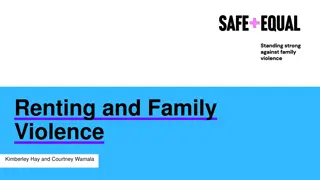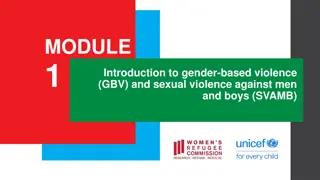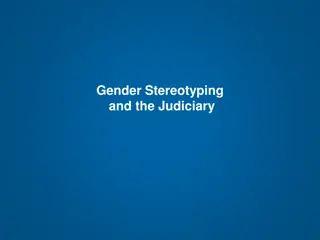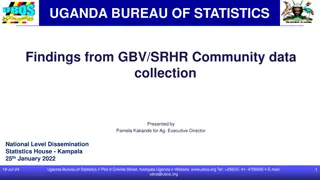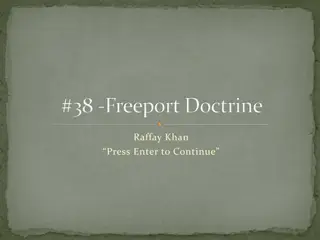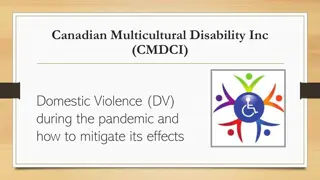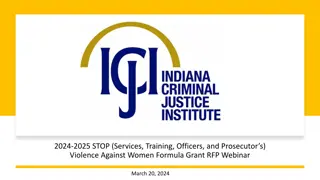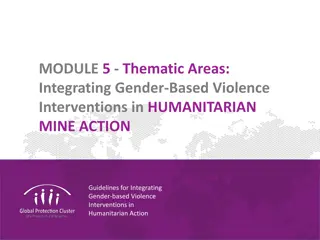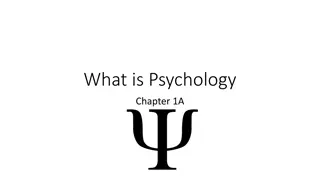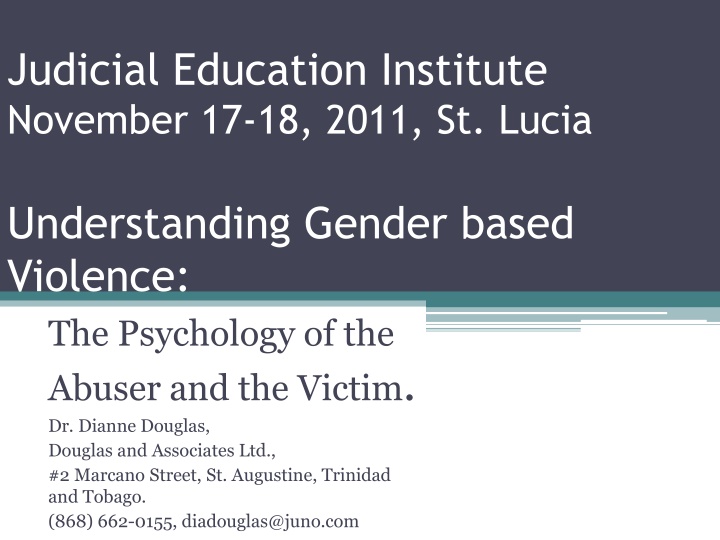
Gender-Based Violence in Trinidad and Tobago
Dr. Dianne Douglas addresses the prevalent issue of gender-based violence in Trinidad and Tobago, highlighting shocking statistics, real-life stories, and the urgent need for awareness and action to combat this societal problem.
Download Presentation

Please find below an Image/Link to download the presentation.
The content on the website is provided AS IS for your information and personal use only. It may not be sold, licensed, or shared on other websites without obtaining consent from the author. If you encounter any issues during the download, it is possible that the publisher has removed the file from their server.
You are allowed to download the files provided on this website for personal or commercial use, subject to the condition that they are used lawfully. All files are the property of their respective owners.
The content on the website is provided AS IS for your information and personal use only. It may not be sold, licensed, or shared on other websites without obtaining consent from the author.
E N D
Presentation Transcript
Judicial Education Institute November 17-18, 2011, St. Lucia Understanding Gender based Violence: The Psychology of the Abuser and the Victim. Dr. Dianne Douglas, Douglas and Associates Ltd., #2 Marcano Street, St. Augustine, Trinidad and Tobago. (868) 662-0155, diadouglas@juno.com
Dr. Dianne Douglas, diadouglas@juno.com Is there a problem? Women's groups estimate that 20-25% of all women in Trinidad and Tobago have suffered abuse UK Foreign and Commonwealth Office, 29 January 2008.
Dr. Dianne Douglas, diadouglas@juno.com Is there a problem? By May 2009, 15 children between the ages of 3-17 were brutally murdered. 6 were shot, six were stabbed or chopped to death 2 were burnt. Express, May 27, 2009
Dr. Dianne Douglas, diadouglas@juno.com Is there a problem? Domestic Violence killed 120 people within the last 5 years. During that same period, the Police Service received 6, 415 reports of Domestic Violence. Ria Taitt, Deaths by DV, Express, 11/11/2009
Is there a problem? Dr. Dianne Douglas, diadouglas@juno.com 18,000 applications annually for protection orders, Lynette Seebaran-Suite 1556 domestic violence related offences, in 2008 In 2009, 1256 In 2010, Females killed as a result of domestic violence, 24 women and 4 children
Dr. Dianne Douglas, diadouglas@juno.com Life Stories In her first book, Before Me, After Me, Tricia St. John tells her story of abuse, rape and how her estranged lover severed her left forearm and right fingers . Domestic violence tears away your pride and self-confidence.
Life Stories Dr. Dianne Douglas, diadouglas@juno.com Karensa Lorsia Diamond, 23, was bludgeoned to death with a hammer by 30 year old Nigel Castillo, who later committed suicide by drinking a poisonous substance. He had a history of physically abusing her but no one thought it would end like this. Express: 12 September, 2011
Life Story A breast cancer victim, 51, confined to a wheel chair, applied for a protection order against her husband who was abusive for 18 years. He threatened to kill her, their 3 children and burn down the house. The order is valid for 3 weeks. Dr. Dianne Douglas, diadouglas@juno.com Express, October 2011
Dr. Dianne Douglas, diadouglas@juno.com Life Story The Marsha Harris Story
Dr. Dianne Douglas, diadouglas@juno.com The Gender Lens
Dr. Dianne Douglas, diadouglas@juno.com What is Gender? Gender can be described as the socially constructed behaviors, attitudes and identities associated with masculinity and femininity. Prof. Rhoda Reddock
Dr. Dianne Douglas, diadouglas@juno.com Gender Expectations Refers to the behaviors and attitudes expected of women and men in particular social and cultural contexts. Prof. Rhoda Reddock
Dr. Dianne Douglas, diadouglas@juno.com Gender Ideologies Are those ideas which define acceptable and unacceptable behaviors for women and men. They may differ from society to society and from era to era. Prof. Rhoda Reddock
Dr. Dianne Douglas, diadouglas@juno.com Gender Identities Are basic to our understanding of self. They are our most fundamental identity and shape how we act in all areas of life. Prof. Rhoda Reddock
Dr. Dianne Douglas, diadouglas@juno.com Defining Domestic Violence
Definition: Domestic Violence Dr. Dianne Douglas, diadouglas@juno.com Domestic violence constitutes the willful intimidation, assault, battery, sexual assault or other abusive behavior perpetrated by one family member, household member, or intimate partner against another. The National Centre for Victims of Crime www.ncvc.org
Dr. Dianne Douglas, diadouglas@juno.com Definition: Domestic Violence The relationship necessary for a charge of domestic assault or abuse generally includes a spouse, former spouse, persons currently or recently residing together, or persons who share a common child. The National Centre for Victims of Crime www.ncvc.org
Dr. Dianne Douglas, diadouglas@juno.com Definition: Domestic Violence Domestic violence is not about isolated incidents of violence, but about a pattern of abusive behaviors with the purpose of dominance (power) and control. UN Women s Partnership for Peace Manual
Dr. Dianne Douglas, diadouglas@juno.com Types of Violence/Abuse
Dr. Dianne Douglas, diadouglas@juno.com Battering A pattern of behaviors through which one person continually reinforces a power imbalance over another in an intimate/romantic relationship context.
Dr. Dianne Douglas, diadouglas@juno.com Physical abuse: Physical abuse is the use of physical force or physical aggression against someone in a way that injures or endangers that person.
Sexual Abuse: Dr. Dianne Douglas, diadouglas@juno.com Any situation in which you are forced to participate in unwanted, unsafe, or degrading sexual activity. Forced sex, even by a spouse or intimate partner with whom you also have consensual sex, is an act of aggression and violence.
Dr. Dianne Douglas, diadouglas@juno.com Psychological or Emotional Abuse Wears down the victim s self-confidence and self-esteem by using verbal abuse: ridicule, jealous accusations, angry reactions, constant criticism, constant accusations of unfaithfulness, monitoring her whereabouts, asking her to closely account for her time or money, humiliating her in front of others and isolating her.
Dr. Dianne Douglas, diadouglas@juno.com Economic or Financial abuse: Rigidly controlling your finances. Withholding money or credit cards. Making you account for every penny you spend. Withholding basic necessities (food, clothes, medications, shelter).
Dr. Dianne Douglas, diadouglas@juno.com Economic or Financial Abuse: Restricting you to an allowance. Preventing you from working or choosing your own career. Sabotaging your job (making you miss work, calling constantly). Stealing from you or taking your money.
Dr. Dianne Douglas, diadouglas@juno.com The Male Abuser
Dr. Dianne Douglas, diadouglas@juno.com Basic Profiles of Abusive Men 1. Possessiveness - view their partner as their property. They do not see their partners as a separate person and equal to them. Their partner is just an extension of who they are. Their partners do not have their own thoughts, feelings, ideas and opinions
Dr. Dianne Douglas, diadouglas@juno.com Basic Profiles of Abusive Men 2. Control & Power- believe they have the right to control their partners, tell their partners what to do, and expect obedience; feel justified in using force to maintain power and control over partners and to displace those feelings of low self- esteem, and get them to comply; feel their partners have no right to challenge this.
Dr. Dianne Douglas, diadouglas@juno.com Basic Profiles of Abusive Men 3. Externalize blame: Will not assume responsibility for their actions; projects the blame for their anger and violence onto others (especially their partners)
Dr. Dianne Douglas, diadouglas@juno.com Basic Profiles of Abusive Men 4. Tendency to justify, deny, minimize, or reframe their behaviour, e.g. someone has to be in charge, I have never hit you, That s not the way it happened at all. You are over-reacting!
Dr. Dianne Douglas, diadouglas@juno.com Basic Profiles of Abusive Men 5. Unrealistic expectations of partners to fulfill their needs. Expect their partners to make them feel happy, make them feel complete, high level of dependency on their partner
Dr. Dianne Douglas, diadouglas@juno.com Basic Profiles of Abusive Men 6. Express most feelings as anger in the form of violence. Don t know how to express hurt, frustration, stress, sadness, fear, etc. Poor communicators. Displaces anger from other sources (work, finances) on to partner.
Dr. Dianne Douglas, diadouglas@juno.com Basic Profiles of Abusive Men 7. Isolation: A tendency to cut partners off from other relationships by complaining, criticizing, refusing to visit or participate in activities with others, finding fault, making their partner choose me or the other, refusing to have others in their home He may or even prevent you from going to work or school. You may have to ask permission to do anything, go anywhere, or see anyone
Dr. Dianne Douglas, diadouglas@juno.com Basic Profiles of Abusive Men 8. Believe in traditional male/female roles. A man is breadwinner, ultimate decision-maker, strong, dominant, superior, successful, restricted emotions
Dr. Dianne Douglas, diadouglas@juno.com Basic Profiles of Abusive Men 9. Need to maintain an over- adequate fa ade: inability to reveal vulnerability or anxiety (with the exception, perhaps, of the period immediately after an abusive incident); avoids their own feelings of dependence
Dr. Dianne Douglas, diadouglas@juno.com Basic Profiles of Abusive Men 10. Alcohol and substance abuse: Alcohol abuse and binge drinking have been consistently associated with partner violence; increases impulsivity, aggression, a disinhibitor,
Dr. Dianne Douglas, diadouglas@juno.com Basic Profiles of Abusive Men 11. Socialized into Aggression: Have been taught directly or indirectly that aggression is an appropriate means of problem- solving, By observing or imitating behaviour, we learn what those around us consider appropriate; victimization and witnessing violence are the most consistent risk factors of adult violence
Dr. Dianne Douglas, diadouglas@juno.com Basic Profiles of Abusive Men 13. Not Usually Mentally Ill: The proportion of mentally ill abusive men is no greater than the proportion of the mentally ill in the population at large
Dr. Dianne Douglas, diadouglas@juno.com Basic Profiles of Abusive Men 14. Can be self-controlled. An abuser may be impulsive and quick-tempered but is able to demonstrate extraordinary control when to do so is in his best interest i.e. around people he is trying to impress, co-workers, the police, the court, etc.
Dr. Dianne Douglas, diadouglas@juno.com Abusive Tactics
Dr. Dianne Douglas, diadouglas@juno.com DOMINANCE Abusive individuals need to feel in charge of the relationship. They will make decisions for you and the family, tell you what to do and expect you to obey without a question. Your abuser may treat you like a child, servant or even his possession.
Dr. Dianne Douglas, diadouglas@juno.com THREATS Used to keep partners from leaving or to scare them into dropping charges. They may threaten to hurt or kill their partner, their children children, other family members, or even pets. They also threaten to commit suicide, file false charges against them, or report them to the police.
Dr. Dianne Douglas, diadouglas@juno.com INTIMIDATION Designed to scare their partner into submission like threatening looks or gestures, smashing things in front of them, destroying property, hurting pets, or putting weapons on display. The clear message is that if you don't obey, there will be violent consequences.
Dr. Dianne Douglas, diadouglas@juno.com Humiliation Will do everything he can to make her feel bad about herself or defective in some way. After all, if she believes she is worthless and that no one else will want her, she is less likely to leave. Insults, name-calling, shaming, and public put-downs are all weapons of abuse designed to erode her self-esteem and make her feel powerless.
Dr. Dianne Douglas, diadouglas@juno.com THE FEMALE VICTIM
A Woman *Nurturer of men and children *Sexy * Express a wide range of emotions *Moral and virtuous *Romantic (fairy tales) *Companion to the man *Incomplete without a man *Judge, Magistrate, Attorney, Psychologist!!! Dr. Dianne Douglas, diadouglas@juno.com
Dr. Dianne Douglas, diadouglas@juno.com The female victim: Abused Woman's Syndrome or Battered Woman Syndrome describes a pattern of psychological and behavioral symptoms found in women living in battering relationships."
Dr. Dianne Douglas, diadouglas@juno.com 4 General Characteristics of the syndrome: 1. The woman believes that the violence was her fault. 2. The woman has an inability to place the responsibility for the violence elsewhere. 3. The woman fears for her life and/or her children's lives. 4. The woman has an irrational belief that the abuser is omnipresent and omniscient. Lenore E. Walker, The Battered Woman, 1979
Dr. Dianne Douglas, diadouglas@juno.com The Woman s Experience PTSD: Fear; nightmares and sleep disturbances; anxiety; anger; difficulty concentrating; depression; social withdrawal, feelings of helplessness and hopelessness, numbness, hypervigilance(inability to relax, jumpiness or startle response), chronic physical complaints; substance abuse
Dr. Dianne Douglas, diadouglas@juno.com WHY SHE STAYS



